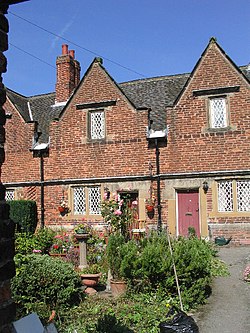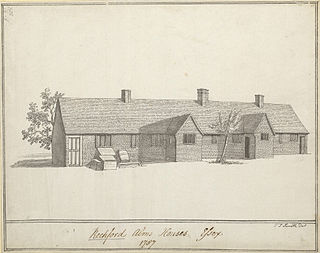
An almshouse is charitable housing provided to people in a particular community, especially during the Middle Ages. They were often targeted at the poor of a locality, at those from certain forms of previous employment, or their widows, and at elderly people who could no longer pay rent, and are generally maintained by a charity or the trustees of a bequest. Almshouses were originally formed as extensions of the church system and were later adapted by local officials and authorities.

The Blockley Almshouse, later known as Philadelphia General Hospital, was a charity hospital and poorhouse located in West Philadelphia. It originally opened in 1732/33 in a different part of the city as the Philadelphia Almshouse. Philadelphia General Hospital closed in 1977.
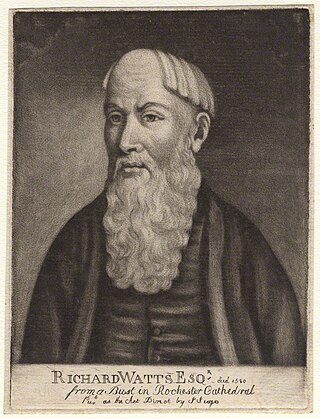
Richard Watts (1529–1579) was a successful businessman and MP for Rochester, South East England, in the 1570s. He supplied rations for the English Navy as deputy victualler and supervised the construction of Upnor Castle. After Queen Elizabeth I pronounced his house was satis after a visit in 1573, the house was thereafter known as Satis House. Famed locally for his philanthropy, he died on 10 September 1579, leaving money in his will to establish the Richard Watts Charity and Six Poor Travellers House in Rochester High Street. He is buried, in accordance with his will, in Rochester Cathedral.
Abel Collin (1653–1705) was a benefactor in Nottingham. He established Abel Collin's Charity.

Gray's Almshouses is a terrace of almshouses in Taunton, Somerset, England, founded in 1635 by the wealthy cloth-merchant Robert Gray, whose monument survives in the Church of St Mary Magdalene. The building is one of the oldest surviving in Taunton and is one of the earliest brick buildings in the county. The Almshouses were designed to provide accommodation for six men and ten women and for a reader who was to act as chaplain and schoolmaster. It is a Grade I listed building as designated by English Heritage. Following renovation in the late twentieth century it now comprises sheltered accommodation of nine flats for the elderly.
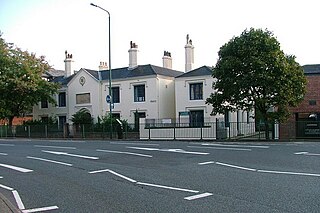
Plumptre Hospital was a charity in Nottingham providing almshouse accommodation for 599 years from 1392 to 1991.

Wright's Almshouses is a terrace of six former almshouses now located on Beam Street in Nantwich, Cheshire, England. The building was originally erected at the junction of Hospital Street and London Road in 1638 by Edmund Wright, Lord Mayor of London in 1640–41, and is listed at grade II*. The low red-brick terrace has stone dressings and a central stone panel with arms. The adjacent stone archway of 1667, which Nikolaus Pevsner describes as the "best" feature of the almshouses, is also listed separately at grade II*, together with its associated wall.

The Tollemache Almshouses, also known as the Wilbraham Almshouses or Wilbraham's Almshouses, are six former almshouses in Nantwich, Cheshire, England. They are in two blocks of three cottages each, located on the north side of Welsh Row at numbers 118–128. The present buildings, which are listed at grade II, were erected in 1870 by John Tollemache to replace adjacent almshouses founded by Sir Roger Wilbraham in 1613. The almshouses were modernised in 1980 and remain in residential use. The Hospital of St Lawrence, a medieval house for lepers, was possibly on or near the site of the present almshouses.

The Widows' Almshouses, also known as the Wilbraham or Wilbraham's Almshouses and as the Widows' Hospital, are former almshouses for six widows in Nantwich, Cheshire, England. They are located at numbers 26–30 on the north side of Welsh Row, on the junction with Second Wood Street. The almshouses were founded by Roger Wilbraham in 1676–7 in memory of his deceased wife in three existing cottages built in 1637; they were the earliest almshouses in the town for women. In 1705, Wilbraham also founded the Old Maids' Almshouse for two old maids in a separate building on Welsh Row. They remained in use as almshouses until the 1930s. The timber-framed Widows' Almshouses building, which is listed at grade II, has subsequently been used as a café, public house, night club, restaurant, wine bar and hotel.

The Frances Jane Longden Almshouses were erected in 1852 in Bramcote, Nottinghamshire, for 4 poor women.

The Norris Almshouses were erected in 1893 on Berridge Road in Sherwood Rise, Nottinghamshire.

The Sir John Robinson Almshouses are a collection of twelve two-bedroom cottages erected in 1899 on Mansfield Road, Daybrook, Arnold, Nottingham, England.

The Elizabeth Almshouses are a collection of four almshouses on Elizabeth Road, Worthing built in 1860 by the architect William Burges. The almshouses were paid for by William's father, Alfred Burges, in memory of Alfred's wife. The building is listed Grade II.

Wandesford House is an eighteenth-century almshouse in the centre of York, England, one of twelve still-functioning almshouses in the city, and the oldest still in its original building. Built in 1739 and opened in 1743, the house is an important example of the classical style in the city. Like many historic almshouses, it was referred to as a hospital before that term became chiefly associated with medical establishments.
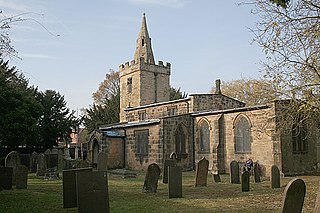
St Catherine's Church, Cossall is a Grade II* listed parish church in the Church of England in Cossall, Nottinghamshire, England.
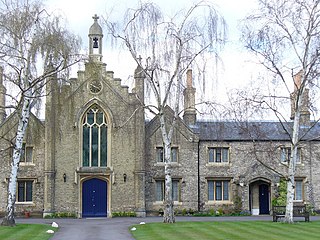
Hickey's Almshouses are almshouses between Sheen Road and St Mary's Grove in Richmond, London.
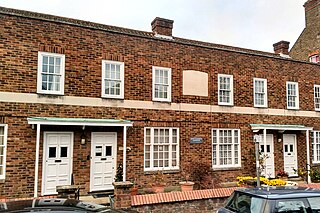
Queen Elizabeth's Almhouses are almshouses in Richmond, London, founded by Sir George Wright in 1600 to house eight poor aged women. Known originally as the "lower almshouses", they were built in Petersham Road, a few hundred yards south of what is now Bridge Street. By 1767, they were almost derelict. In 1767, William Turner rebuilt the almshouses on land at the top end of his estate in The Vineyard. Funds for the rebuilding were raised by public subscription. The almshouses were rebuilt again in 1857. They were damaged during World War II and replaced with four newly built houses in 1955.

Richard Watts Charities incorporate Richard Watts Charity set up in the will of Richard Watts in 1579, as well as several other charities in Rochester, Medway. The will originally provided for an almshouse in Rochester High Street: The Poor Travellers House; over time, the money later provided for almshouses in Maidstone Road, along with other accommodation in Rochester, totalling 66 self-contained flats. Other charities absorbed by the Richard Watts Charity include St Catherine's Hospital founded under the Charity of Symond Potyn in 1315.
Cossall is a civil parish in the Borough of Broxtowe, Nottinghamshire, England. The parish contains six listed buildings that are recorded in the National Heritage List for England. Of these, two are listed at Grade II*, the middle of the three grades, and the others are at Grade II, the lowest grade. The parish contains the village of Cossall and the surrounding area. All the listed buildings are in the village, and consist of a church, two war memorials in the churchyard, a row of almshouses, and two cottages.
